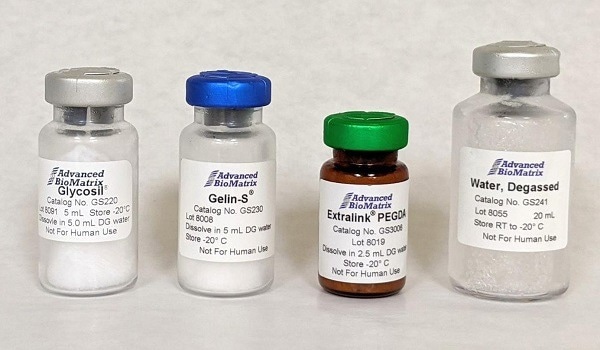Overview
The final pH, osmo, and rheological characteristics of HyStem Version 2.0 are identical to those of Version 1.0, but it is more flexible and reliable.
For enhancing the matrix for cell culture, HyStem®-C hydrogels make a great place to start. Three biocompatible components make up HyStem-C, which is fully chemically defined and based on thiol-modified hyaluronan (Glycosil), thiol-reactive crosslinker, PEGDA (Extralink), and thiol-modified denatured collagen (Gelin-S®).
It is advised that Gelin-S be used as an ideal substrate for adherent cell types and for cell culture optimization because it offers fundamental cell-attachment sites for a variety of primary cells and cell lines. In some circumstances, the augmentation of HyStem-C hydrogels with ECM proteins to mimic native signals is possible.

Image Credit: Advanced BioMatrix
The product may be shipped at room temperature, but it should be stored at –20 °C until needed.
Features
- Hydrogels can be easily customized by the user to possess the desired stiffness and gelation time by manipulating component concentration and mixing ratios
- Hydrogels are suitable for culturing primary cells, stem cells, and cell lines
- Cells can be encapsulated or grown on the hydrogel surface in any format, including culture flasks, 6- to 384-well plates, or tissue culture inserts
- Customizable gelation properties including gelation time and hydrogel stiffness
Applications
Gelation
- At 15 to 37 °C, reconstituted HyStem-C components are still liquid. When the crosslinking agent Extralink® (PEGDA) is added to a mixture of Gelin-S® and Glycosil® (thiol-modified hyaluronan), the hydrogel is created (thiol-modified gelatin)
- Once all three components have been combined, gelation takes place in about twenty minutes
- Low pH or low temperatures have no bearing on any steps. The gelation time can be prolonged by diluting the ingredients with a cell culture medium or phosphate-buffered saline (PBS)
3D cell recovery matrix
- The alternative crosslinker PEGSSDA is available for use with all HyStem, HyStem-C, and HyStem-HP kits for applications where cell recovery is crucial. In addition to offering the same benefits as Extralink, this crosslinker also has the advantage of having easily reducible internal bonds
- Instead of using slow enzymatic techniques that may affect cell viability, this enables quick, simple recovery of single cells or clusters from the hydrogel for applications like RNA analysis or flow cytometry